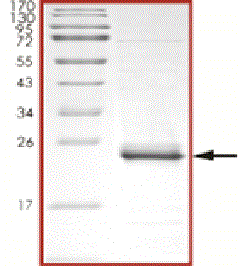
HRAS (G12V) Protein(R05-32VTH)
FOR BULK ORDER REQUESTS PLEASE CONTACT US
Description :Recombinant human HRAS (G12V) (2-186) was expressed in E. coli cells using an N-terminal His tag. HRAS (G12V) is constitutively active. The His tag may be cleaved with TEV Protease (Cat# T525-31H).
Species :Human
Tag :HIS
Expression System:E.coli
Sequence :(2-186)
Genbank Number :NM_005343
Alternative Name(s) :C-BAS/HAS; C-H-RAS; C-HA-RAS1; CTLO; H-RASIDX; HAMSV; HRAS1; K-RAS; p12ras; RASH1
Formulation :Recombinant protein stored in 50mM sodium phosphate, pH 7.0, 300mM NaCl, 150mM imidazole, 0.25mM DTT, 25% glycerol.
Storage and Stability :Store product at –70oC. For optimal storage, aliquot target into smaller quantities after centrifugation and store at recommended temperature. For most favorable performance, avoid repeated handling and multiple freeze/thaw cycles.
Scientific Background :The RAS gene superfamily encodes a group of closely related 21,000 dalton (p21) proteins with special affinity for guanine nucleotides (GTP). RAS and several other cellular proteins with similar biochemical properties are collectively known as G-proteins and they play key roles in a wide variety of cellular activities, including cell growth, differentiation, secretion, and protein trafficking (1). There are three forms of RAS gene in cells termed H-RAS, N-RAS, and K-RAS. RAS proteins play a direct causal role in human cancer and in other diseases. Mutant H-RAS, N-RAS, and K-RAS occur in varying frequencies in different tumor types (2). Other members of the RAS superfamily may also contribute to cancer.
References :1. Shih, T. Y., et al: Structure and function of p21 ras proteins. Gene Amplif Anal. 1986;4:53-72.
2. Rodriguez-Viciana, P.: Cancer targets in the Ras pathway. Cold Spring Harb Symp Quant Biol. 2005;70:461-7.
Purity :Sample Purity Data. For specific information on a given lot, see related technical data sheet.
Molecular Weight :Calculated MW ~21 kDa.
Product Sheets (By Lot #) :
Research Areas :Cancer, Cell Cycle, Cellular Stress
